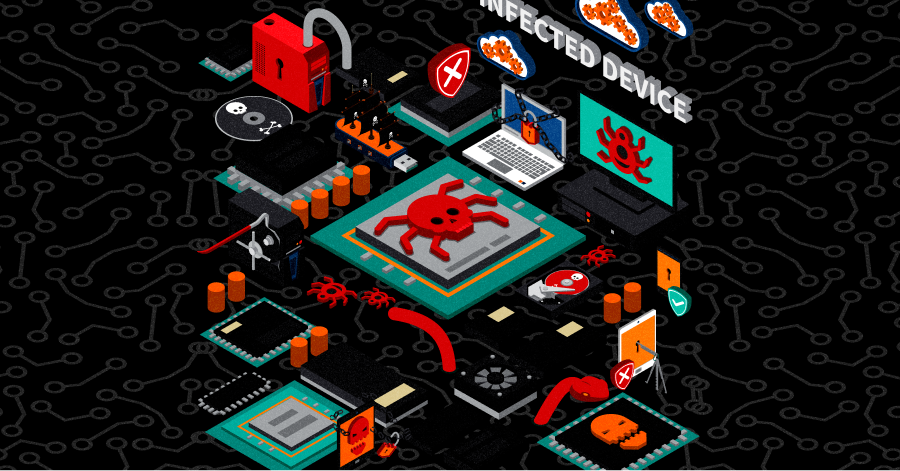David Glimore
Cyber Security Analyst at Threat Intelligence and artificial intelligence researcher.
David Gilmore • September 3, 2024


David Glimore
Cyber Security Analyst at Threat Intelligence and artificial intelligence researcher.
In recent years, the manufacturing sector has become an increasingly attractive target for cybercriminals. This industry, essential to global supply chains and economies, has faced a significant surge in ransomware attacks. The implications of these attacks are profound, impacting not only the victim companies but also their customers and broader supply chains. This blog post delves into the current state of cyber attacks on the manufacturing sector, exploring the trends, tactics, and impacts of these malicious activities and what manufacturing organisations can do to limit the impact of a ransomware attack.
Ransomware continues to be a dominant threat to the manufacturing industry. According to a 2024 report by Sophos, 44% of computers in manufacturing and production environments were affected by ransomware in 2023. This alarming statistic highlights the vulnerability of this sector to such attacks. The report also notes that ransomware attacks on manufacturing entities are becoming more sophisticated and targeted, with cybercriminals exploiting specific vulnerabilities unique to industrial environments, such as those in industrial control system software.
Some manufacturing companies rely on older legacy systems to operate machinery, often reluctant to upgrade to newer software systems due to costs, potential downtime, and compatibility issues. These obstacles present an opportunity for malicious threat actors to exploit outdated systems, which may have software or firmware vulnerabilities.
The frequency of cyber attacks on the manufacturing sector has seen a significant rise. Cybersecurity Dive reports that the number of ransomware incidents in this sector has more than doubled over the past two years. These attacks are not only increasing in number but also in their impact. For instance, the Colonial Pipeline attack in 2021, which led to widespread fuel shortages across the United States, underscored the devastating potential of cyber attacks on critical infrastructure.
Similarly, a report by SC Magazine highlights a sharp spike in industrial ransomware attacks, with manufacturing being the most affected sector. The report notes that these attacks are often highly disruptive, leading to substantial financial losses and operational downtime. In many cases, companies are forced to halt production entirely until the issue is resolved, further amplifying the economic impact.
IBM’s recently released "Cost of a Data Breach 2024 Report" highlights the concerning statistic that the average time to identify a cybercriminal in an IT system is 200 days, and the average time to contain the breach once an intruder has been detected is 70 days. That is, on average, 270 days from the time companies realise their systems have been infiltrated, to containing a breach.
Cybercriminals employ various tactics to breach manufacturing networks. One of the most common methods used to gain initial access is phishing, where attackers trick employees into clicking on malicious links or downloading attachments that contain malware. This allows threat actors to capture login credentials or infect systems with malicious code that can steal credentials and allow them to traverse the network, seeking sensitive systems or data. Once inside a network, attackers often deploy ransomware to encrypt critical data, demanding a ransom for its release.
Another prevalent tactic is the use of remote access tools to gain control of industrial control systems. These systems, which manage and monitor production processes, are often connected to the internet, making them susceptible to cyber attacks. In some cases, attackers have used these tools to manipulate production processes, causing significant disruption and damage.
Several high-profile cases illustrate the growing threat of cyber attacks in the manufacturing sector. For instance, the ransomware attack on Norsk Hydro in 2019 severely disrupted the company's operations across multiple countries. The attack, which cost the company around $70 million, highlighted the potential scale and impact of cyber threats on global manufacturing operations.
Another notable case is the attack on Honda in 2020, which forced the company to halt production at several plants worldwide. The attack, attributed to the Snake ransomware, affected the company's internal servers and communication systems, demonstrating the widespread impact such incidents can have on a major automotive manufacturer.
The financial implications of cyber attacks on manufacturing companies are substantial. Beyond the immediate costs of ransom payments and recovery efforts, companies also face long-term financial impacts. These include lost revenue due to production downtime, legal and regulatory fines, and increased cybersecurity insurance premiums. According to a study by Cybereason, the average cost of a ransomware attack on a manufacturing company is approximately $1.85 million, not including the potential reputational damage and loss of customer trust.
Operational impacts are equally significant. Cyber attacks often lead to extended periods of downtime, disrupting production schedules and supply chains. In highly automated environments, even a short disruption can have cascading effects, leading to delays and increased costs. Moreover, the recovery process can be lengthy and complex, requiring substantial resources and expertise.
Given the increasing threat landscape, robust cybersecurity measures are essential for manufacturing companies. Implementing comprehensive cybersecurity strategies can help mitigate the risks and minimize the impact of cyber attacks. Key measures include:
As the manufacturing sector continues to evolve, so too will the cyber threats it faces. The increasing adoption of Industry 4.0 technologies, such as the Internet of Things (IoT) and artificial intelligence (AI), presents new opportunities for efficiency and innovation. However, these technologies also introduce new vulnerabilities and attack vectors that cybercriminals can exploit.
To stay ahead of these evolving threats, manufacturing companies must continuously adapt their cybersecurity strategies. This includes investing in advanced security technologies, fostering a culture of cybersecurity awareness, and collaborating with industry partners and government agencies to share threat intelligence and best practices.
The manufacturing sector is a critical component of the global economy, making it an attractive target for cybercriminals. The increasing frequency and severity of cyber attacks on this industry underscore the urgent need for robust cybersecurity measures. By understanding the threats and implementing comprehensive security strategies, manufacturing companies can better protect their operations and ensure the resilience of their supply chains. As the cyber threat landscape continues to evolve, staying vigilant and proactive will be key to safeguarding the future of manufacturing.
Contact us today for a personalised consultation to discover how the Evolve suite of products can meet your specific security needs. Our team will work with you to assess your current security posture, identify potential vulnerabilities, and tailor a solution that maximises protection and efficiency.
Schedule a consultation with one of our experts today!
Related Content